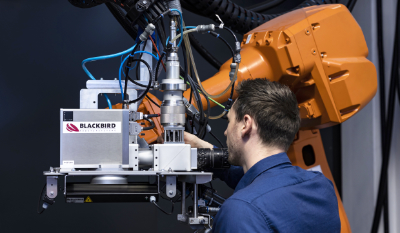SCANLAB GmbH together with its sister companies Blackbird Robotersysteme GmbH and Holo/Or Ltd. are developing promising new system concepts for laser applications such as laser welding of bipolar plates and additive manufacturing (metal 3D printing).
By integrating tailored beam shapers, the novel scan setup showed the potential to nearly double the productivity of welding bipolar plates for hydrogen fuel cells.
Fuel cell technology has been considered a niche market for a long time. Due to the transition phase in energy generation and the search for alternative drives, the market demand is likely to grow significantly. For efficient mass production, an increase of throughput in welding of metal bipolar plates, used to build the stacks in a fuel cell, is needed. High welding speeds require fast scan systems and high power lasers, both available. However, it’s the welding process itself which determines the maximum reachable speed. Weld seam failures such as humping effects and undercut occur when a certain speed limit is exceeded.
Blackbird Robotersysteme set up a test rig integrating the 2D scan head intelliSCAN from SCANLAB and HOLO/OR’s latest development the Flexishaper, a full range adjustable beam shaper. The necessary beam shape was determined based on welding process simulations. The layout of the utilised beam shaper was the result of a combined optical design, integrating both diffractive optical elements (DOE) and scan system. The processing tests demonstrated to shift the speed limit of failure free welding speed from 45 m/min up to 70 m/min.
Adopting processing experience with DOEs
Thin sheet welding of bipolar plates has similar requirements to laser powder bed fusion (LPBF) processes. Both require scan field sizes up to 500 x 500 mm² with a typical processing speed around 1m/s and below. Also in metal 3D printing the processing speed is not limited by the speed of the scanner or the available laser power, but it is mostly the process itself which limits the throughput. Thus, the encouraging laser welding results are the first step on the way to further optimise LPBF processes in addition.
“Our joint company holding creates the trust that is necessary for such a close cooperation to explore innovative solutions. Only in a setup like this you can openly analyse the upcoming market requirements and transfer the outcome in an optical design” recounts Georg Hofner, CEO SCANLAB.
The next steps will be to test the laser welding concept in a larger scale setup and to pursue different applications in parallel. As the fiberSYS meets requirements of both LPBF and laser welding processes, the integration of DOEs into this scan system, particularly suited for multi head laser machines, was included in the development road map.
Contact: Eva Jubitz
